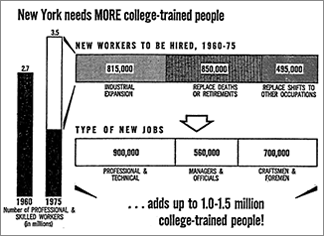1946-1960 Municipal College Expansion
The postwar era witnessed an enormous expansion of state-based public higher education systems, including both senior and community colleges, across the country (the robust and decades-old California system representing the most significant example). New York State was very slow, however, to build and support its own comprehensive state-supported system of public higher education. The State University of New York (SUNY) was only created in 1948; it wouldn’t be significantly expanded until the first decade of Nelson Rockefeller’s governorship, which began in 1958. During this time SUNY grew to nearly 60 campuses, half of which were built anew by the state. See the CUNY Digital History Archive's Heald Commission Report. (The 1960 Heald Commission was appointed by Nelson Rockefeller to plan NY State’s public university expansion.) The Commission Report contains this chart that anticipates New York City's need for skilled and educated workers in its argument for more colleges.
While the city’s municipal college system continued to be lauded as the “the poor man’s Harvard” in the postwar years, the four existing NYC public colleges (City, Hunter, Brooklyn, and Queens) could not expand sufficiently, as SUNY had, to meet the demand for higher education among city residents. The city’s population (totaling nearly 8 million) was undergoing major changes in the postwar era, with nearly one million African Americans and Puerto Ricans replacing an equal number of white New Yorkers who had moved out of the city to nearby suburbs. Increased delivery of social and human services to NYC residents, many of them implemented in response to demands by trade union and civil rights activists, further burdened the city’s already straitened finances. The CUNY Digital Archive's item on The Queens College Civil Rights Archives places CUNY activism within the larger context of the national Civil Rights movement.
While the rest of the country aggressively built community colleges to meet the spiraling public demand for higher education, New York City and the Board of Higher Education did so only reluctantly. The first municipal community college would not open in Staten Island until 1955, with two more to follow in the Bronx and Manhattan over the next four years. Yet these three new community colleges added a total of only 3,000 new students by 1960 to the municipal college rolls. These new community college students were also initially forced to pay tuition (a policy that wasn’t finally changed until 1964-65). Ironically, admission to the municipal colleges, both four-year and community, that had earned the sobriquet “the poor man’s Harvard” had become nearly as exclusive as their Boston namesake. As the decade of the 1960s dawned it took an ever-higher high school average to secure entry into both the four-year and community colleges in the city. That continuing exclusivity helped assure that the municipal colleges were overwhelmingly white (Brooklyn College remained 98 percent white as late as 1968) and increasingly middle class and Jewish in these years. They would soon face a series of political, demographic, and economic challenges.
[This essay is based on Austerity Blues: Fighting for the Soul of Public Higher Education, by Stephen Brier and Michael Fabricant, October, 2016.]
3 Featured Items:
Oral History Interview with Members of The Newt Davidson Collective
Audio and transcription of oral history interview with Nanette Funk, Jerry Markowitz, Bill Tabb, and Mike Wallace, four of the original members of The Newt Davidson Collective.
"New York needs MORE college-trained people" (from Heald Commission Report)
This image from the Heald Commission Report shows the projected need for skilled and college -educated workers in its argument for additional colleges. Upon his election as governor in 1959, Nelson Rockefeller established a committee to examine the [...]
Israel Kugler Biographical Video
Produced by the Professional Staff Congress (PSC), the union which represents CUNY faculty and staff, this short video features the life of Israel Kugler, a labor leader for faculty at several New York colleges and a “pioneer in academic [...]
